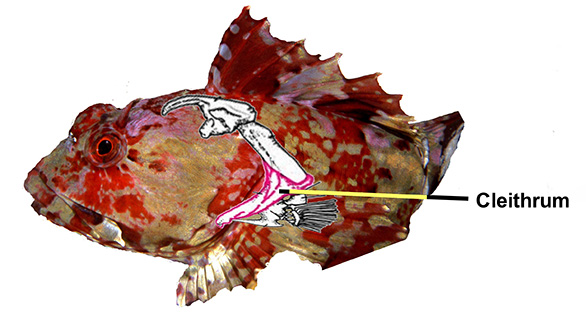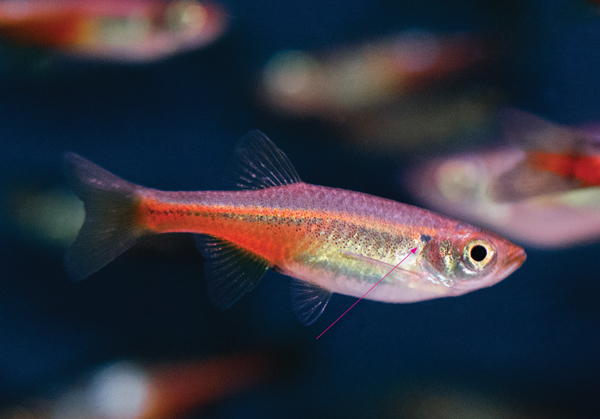
Sculpin with location of cleithrum, an internal bone that is part of the pelvic girdle behind the gill arch, indicated. In some fish species, an external mark can be seen adjacent to the cleithrum.
A Puzzling Term from Fish Anatomy: The Cleithral Spot
As with anything in life, the significance of a spot varies with one’s perception. Lady Macbeth saw a spot of blood on her hands that truly was a manifestation of her guilt in convincing her husband to murder his King. At the other extreme, a spot on the faces of Marilyn Monroe and Cindy Crawford was said to help their status as beautiful women (as if they needed help in that regard). And, in Vienna, a certain “Sigmund” was rumored to say, “Sometimes a spot is simply a spot.”
In taxonomy, however, spots, simple and otherwise can assume an importance that can range from trivial to exceptional. This is simply because spots that are in a consistent position can be, and often have been, used as taxonomic characters. Simply put, “cleithral spot” is a name for a color/skin pattern feature, given to (in this case below) a dark spot because it is positioned over the internal skeletal feature, the cleithrum. If one knows fish skeletal features, the cleithrum is a fairly prominent bone in the pectoral girdle, so saying the spot is a “cleithral spot” actually tells some pertinent details about the position of the marking. Not all fish have such a spot, even in groups of similar species from the same general geographic region.
A case in point are some of the small fish now being imported from Myanmar since the government there has started to become more open to foreign enterprises. These are Danionine fish in the genus Devario as well as their near relatives in the genera Betadevario, Danio, Devario, Microdevario, Chela, Microrasbora, and others. These fish often have patterns of lines, many tiny spots arranged irregularly, and one, or more, larger spots, on the body which are used as characters that help define these genera and species with them.
New species entering the aquarium trade always bring excitement, but there can also be confusion, and I was asked a question about one of these fishes that took a bit of answering and I thought it might be relevant to a short blog. Triggered by this image, the question was:

Note arrow to cleithral spot, a dark freckle behind the gill cover on each flank near the lateral line on Devario sondhii, the Fireline Danio. Image The Wet Spot Tropical Fish.
What is a cleithral spot?
This is not a trivial question as can be seen from the examples below, showing instances where the term cleithral spot, as well as some other spots have been used to distinguish species or in species descriptions.
A few cases in point are listed below.
Use: Danio feegradei Hora, 1937 and Danio absconditus, new species are … Distinguished from all other species of Danio except D. absconditus by the presence of a large, elongate black spot at the base of the caudal fin … a a small black or grey cleithral spot and a light (orange in life) spot immediately above… the cleithral spot (vs. absent; or present, large and not bordered by light spot) in D. assamila Kullander, D. catenatus Kullander, D. concatenatus Kullander, D. dangila, and D. sysphigmatus Kullander;
In: Kullander, SO, and Britz, R. 2015. Description of Danio absconditus, new species, and redescription of Danio feegradei (Teleostei: Cyprinidae), from the Rakhine Yoma hotspot in south-western Myanmar…. Zootaxa. Available from http://www.biotaxa.org/Zootaxa/article/download/zootaxa.3948.2.5/12757.
Use: Schistura amplizona a black spot at the base of the upper principal caudal fin rays Vanmanenia serrilineata Kottelat, 2000 dorsal fin with 2−3 irregular rows of brown spots;
In: Endruweit, M. 2014. Four new records of fish species (Cypriniformes: Nemacheilidae, Balitoridae; Characiformes: Prochilodontidae) and corrections of two misidentified fish species (Tetraodontiformes: Tetraodontidae; Beloniformes: Belonidae) in Yunnan, China. Zoological Research 35 (1): 51−58. doi:10.11813/j.issn.0254-5853.2014.1.051 ( …. Available from https://tspace.library.utoronto.ca/handle/1807/64935.
Use: Danio dangila is … distinguished by the cleithral spot in the shape of a short vertical stripe (vs. a round spot in all similar species). Four new species are described… with round cleithral spot and each diagnosed by…species specific colour pattern. Danio assamila, new species, Danio catenatus, new species, and D. concatenatus, new species, Danio sysphigmatus, new species. Those five species…make up a distinctive group within Danio, diagnosed by …and the presence of a prominent cleithral spot.
In: Kullander, S. O. 2015. Taxonomy of chain Danio, an Indo-Myanmar species assemblage, with descriptions of four new species (Teleostei: Cyprinidae). Ichthyol. Explor. Freshwaters, Vol. 25, No. 4, pp. 357-380, 5 figs., 7 tabs., March 2015 …. Available from http://www.pfeil-verlag.de/04biol/pdf/ief25_4_08.pdf.
Diagnostic characters such as spot, lines, color bands, and color patches must be unambiguously described positionally if they are be useful as characters that can be used to separate and identify unknown animals. It is very useful to name these colored regions in relation to some consistent internal skeletal feature (such as the cleithral bone) or some external landmark, such as the caudal fin.
The attached illustration, top, of a sculpin’s front end, shows a drawing of the cleithral bone. Any external spot that appears regularly above or near or where the person naming the species thinks the cleithral bone is located can be called a cleithral spot.
Happy trails in your search for cleithral and other spots…
Fireline Danio with clithral spot (image): http://www.reef2rainforest.com/2015/11/18/species-snapshot-fireline-danio/





Trackbacks/Pingbacks